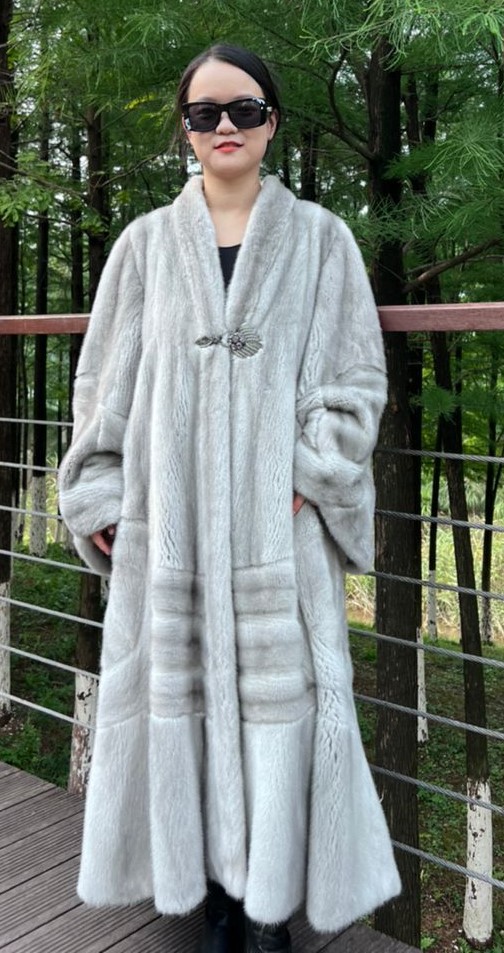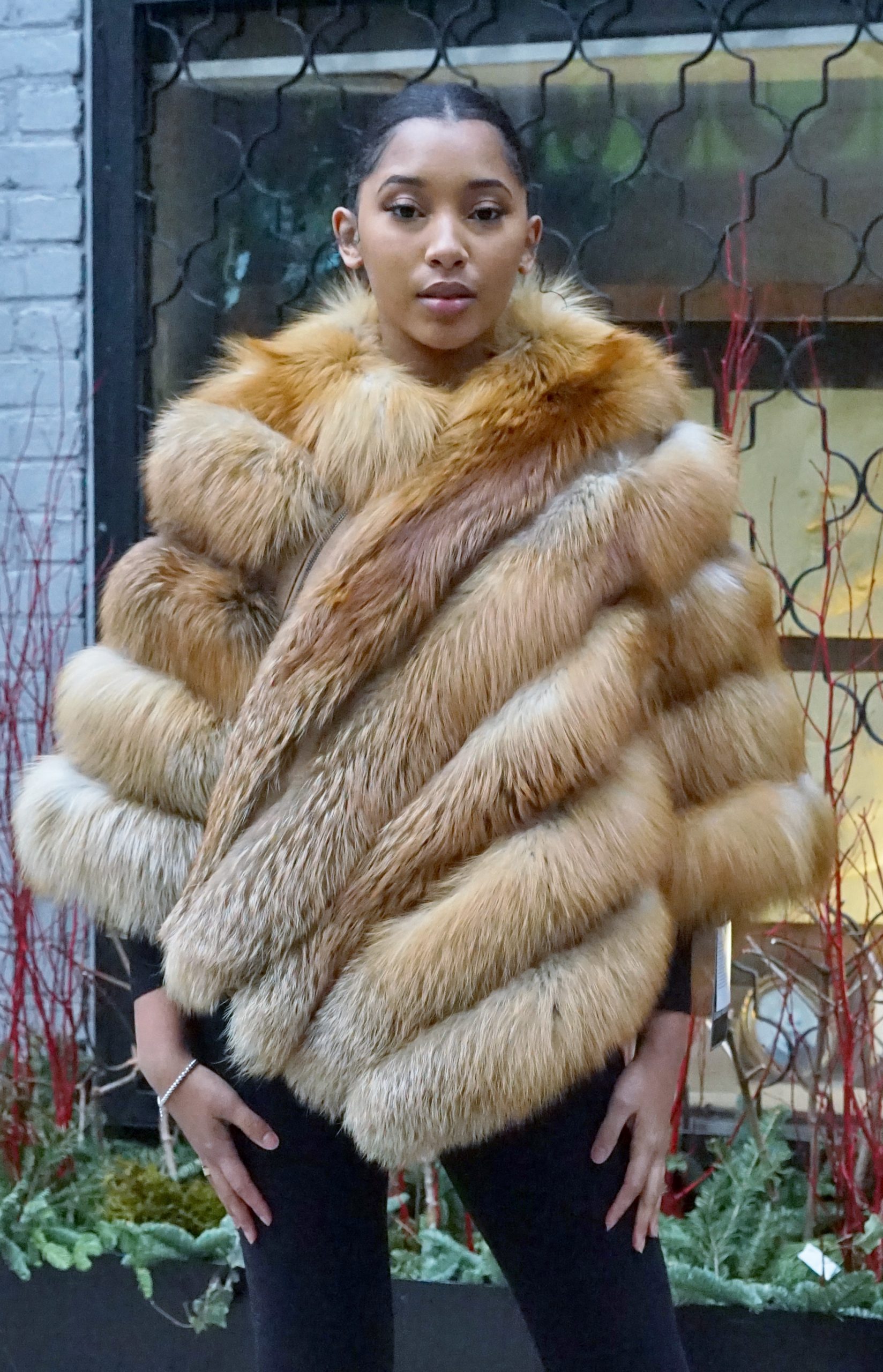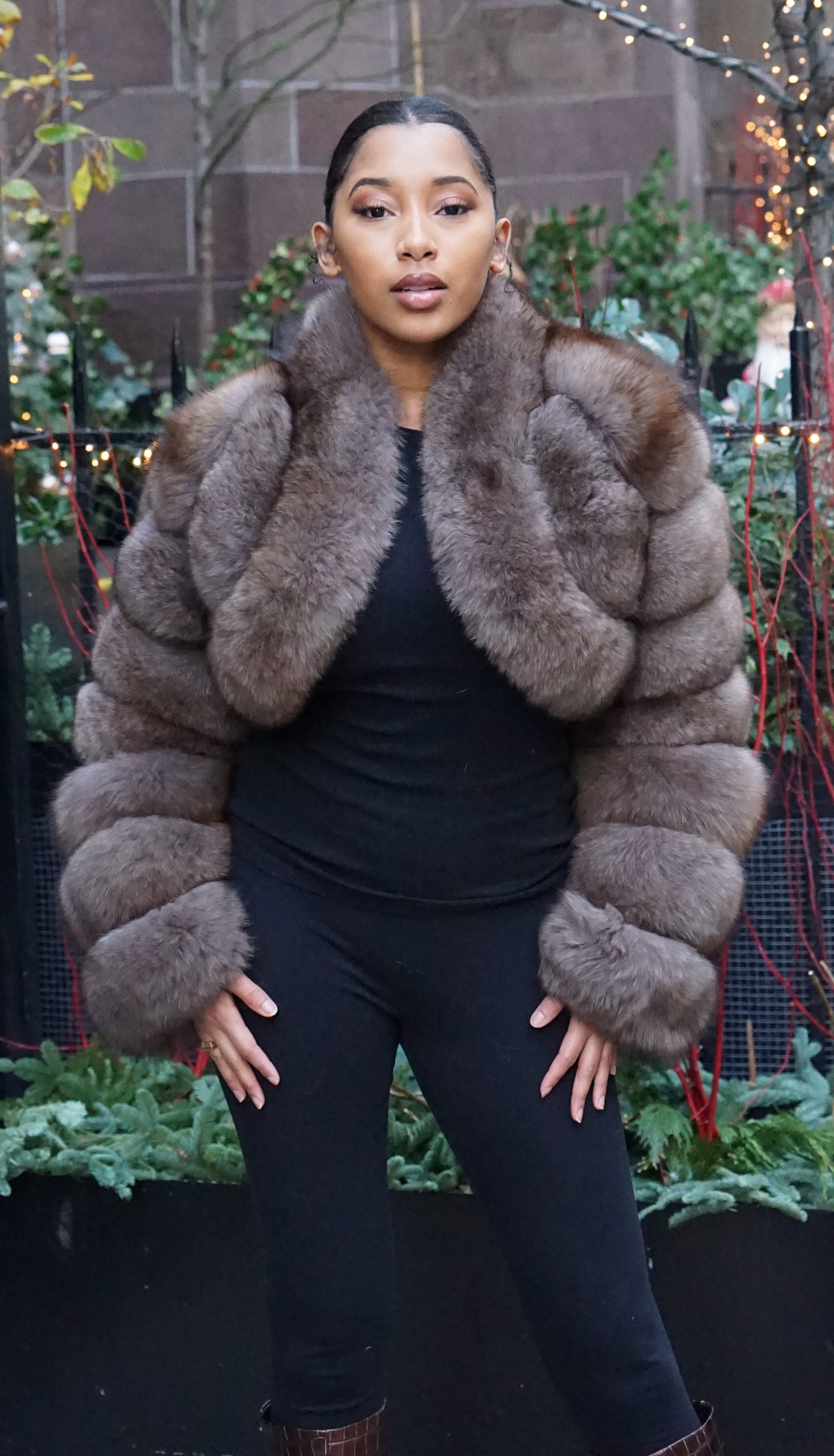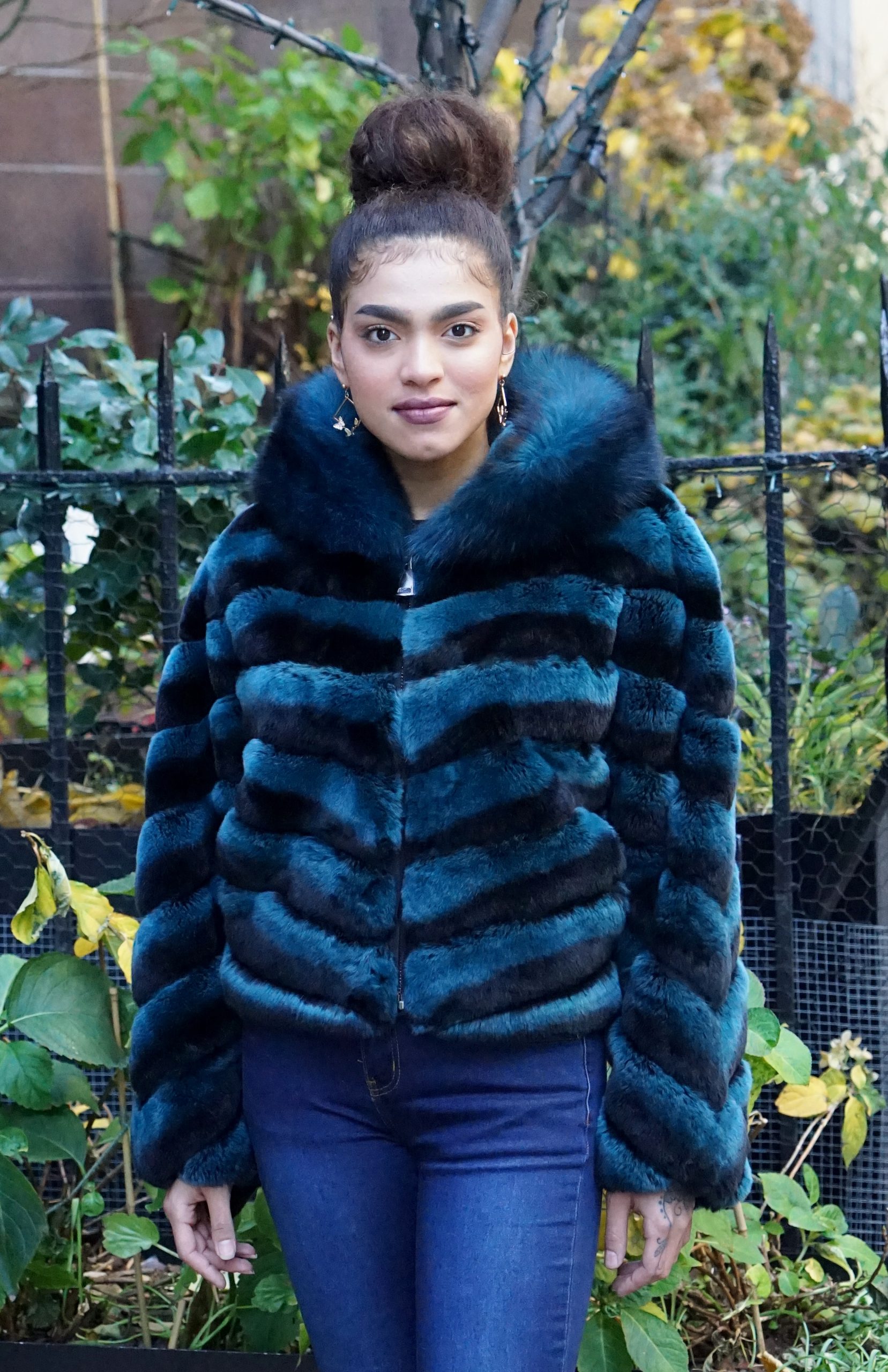The Warmth of Fur
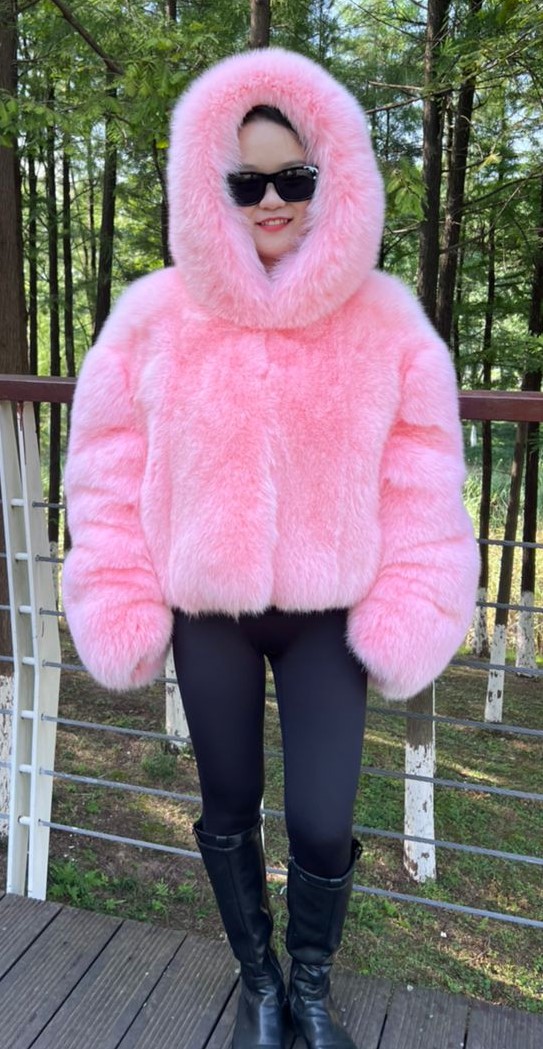
Pink Fox Hooded Jacket
100 Reasons Fur is Warm
Furs are known for their warmth due to several inherent properties and characteristics. Here are 50 reasons why furs are so warm:
- Insulating air pockets: Fur traps air within its fibers, creating insulating layers that retain warmth.
- Hollow hairs: Some fur types have hollow hairs that enhance insulation by trapping more air.
- Natural insulation: Fur is a natural insulator, keeping the body warm in cold conditions.
- Dense fur structure: Many fur-bearing animals have dense fur, which provides better insulation.
- Thickness: Fur can be thick, providing excellent insulation against the cold.
- Softness: Soft fur can trap air more effectively, improving insulation.
- Layering: Some animals have multiple layers of fur, increasing insulation.
- Underfur: Many fur-bearing animals have a soft underfur beneath the coarser outer fur, offering additional insulation.
- Natural oils: Fur often contains natural oils that help repel moisture and maintain warmth.
- Water resistance: Fur is naturally water-resistant, keeping the body dry and warm.
- Wind resistance: Fur can act as a barrier against wind, preventing cold air from penetrating.
- Fur density: High-density fur provides superior insulation.
- Loftiness: Fur can be fluffy and lofty, creating more air pockets for insulation.
- Adaptation to cold climates: Fur-bearing animals have evolved to thrive in cold environments, so their fur is naturally warm.
- Trapping heat: Fur effectively traps body heat close to the skin.
- Thermal regulation: Fur helps regulate body temperature by maintaining a consistent warmth.
- Natural warmth: Fur provides warmth without the need for added insulation or heating elements.
- Breathability: Fur is breathable, allowing moisture to escape while retaining warmth.
Sapphire Directional Mink Coat
- Lightweight: Fur is lightweight, making it easy to wear without feeling bulky.
- Flexibility: Fur is flexible and allows for ease of movement while still providing warmth.
- Durability: Fur coats can last for many years, maintaining their insulating properties.
- Camouflage: Fur helps animals blend into their environments, reducing heat loss due to predators.
- Natural resilience: Fur fibers regain their shape after compression, preserving their insulating properties.
- Adaptation to temperature changes: Fur adapts to temperature fluctuations, ensuring comfort.
- Fur color: Dark fur absorbs more sunlight, adding extra warmth.
- Sun reflection: Light-colored fur reflects sunlight, preventing overheating in warmer conditions.
- Regrowth: Fur naturally regrows, ensuring consistent warmth for the animal.
- Low conductivity: Fur has low thermal conductivity, which means it doesn’t readily conduct heat away from the body.
- Resistance to heat loss: Fur minimizes heat loss through radiation, convection, and conduction.
- Layered design: Fur-bearing animals often have multiple layers of fur that work together to provide insulation.
- Windbreak: Fur acts as a natural windbreak, shielding the body from cold winds.
Red Fox Diagonal Poncho
- Resistance to moisture: Fur repels moisture, preventing the body from getting wet and cold.
- Adaptation to specific environments: Different fur types are adapted to specific climates and conditions.
- Fur thickness distribution: Some areas of an animal’s body may have thicker fur, enhancing warmth.
- Heat retention: Fur retains heat even in extremely cold conditions.
- Heat reflection: Fur can reflect some body heat back towards the body.
- Hydrophobic qualities: Many fur types resist water, which is critical for maintaining warmth.
- Cold resistance: Fur adapts to extreme cold, making it suitable for harsh winters.
- Soft underlayer: The soft underlayer of fur provides comfort and extra warmth.
- Evolved design: Fur coats have evolved over generations to optimize warmth.
Multi Colored Mink Pullover
- Natural movement: Fur moves with the body, preventing heat loss through gaps.
- Weather resistance: Fur remains effective even in inclement weather.
- Hair follicle design: Hair follicles are arranged to trap air and provide insulation.
- Fur texture: Soft, plush fur textures enhance warmth.
- Lining properties: Some furs are used as linings to add warmth to clothing.
- Layering potential: Fur can be layered for added insulation.
- Minimal heat loss: Fur minimizes heat loss through radiation and convection.
- Responsiveness to temperature: Fur adapts to temperature changes, providing comfort.
- All-natural: Fur is a completely natural and renewable source of warmth.
- Lightness: Fur is lightweight and doesn’t add unnecessary bulk to clothing.
- Soft-to-touch: Fur feels comfortable against the skin, enhancing warmth.
- Long-lasting: Well-maintained fur products can provide warmth for many years.
- Versatility: Fur can be used in various clothing items, from coats to hats and gloves.
- Thermal efficiency: Fur efficiently retains body heat without overheating.
fox jacket
- Insulating properties: Fur is commonly used in cold-weather gear for its insulating qualities.
- Temperature moderation: Fur helps maintain a stable body temperature in cold environments.
- Easy maintenance: Fur requires minimal care to retain its insulating properties.
- Non-irritating: Fur is gentle on the skin and does not cause irritation or discomfort.
- Sustainable: Fur is a renewable resource, making it an eco-friendly choice for warmth.
- Historical use: Fur has been used for centuries by various cultures as a warm and practical material.
- Fashionable: Fur remains a popular choice for fashion due to its warmth and style.
- High-quality craftsmanship: Fur garments are often meticulously crafted for maximum warmth.
- Natural beauty: Fur products are prized for their natural, aesthetic appeal.
- Texture variety: Fur comes in various textures, each with its own insulating qualities.
- Comfortable fit: Fur clothing is often designed for a snug yet comfortable fit that maximizes warmth.
- Insulating gloves: Fur-lined gloves provide exceptional warmth for the hands.
- Cold-weather accessories: Fur is used in hats, scarves, and earmuffs for added warmth.
- Luxurious feel: The softness and luxurious feel of fur add to its warmth.
- Climate adaptation: Different fur types are suited to different climates, offering optimal warmth.
- Skin-fitting: Fur can be designed to fit close to the body, minimizing heat loss.
- Flexibility in design: Fur can be incorporated into various styles of clothing for different levels of warmth.
- Insulating properties of fur-lined boots: Fur-lined boots provide warmth to the feet in cold conditions.
- Thermal balance: Fur helps maintain a balanced body temperature in cold weather.
- Comfortable microclimate: Fur creates a comfortable microclimate close to the skin.
- Maintains warmth when wet: Some types of fur retain their insulating properties even when wet.
- Resistance to frostbite: Fur can help prevent frostbite in extreme cold.
- Aesthetic appeal: Fur adds a touch of elegance and sophistication to winter fashion.
- Cold-weather tradition: Fur has been a traditional choice for staying warm in cold climates.
- Effective windbreak: Fur can block the wind effectively, reducing heat loss.
- Breathable: Fur allows moisture to escape while maintaining warmth.
- Natural renewal: Fur regrows naturally, ensuring a consistent source of warmth for the animal.
- Temperature adaptability: Fur adjusts to the body’s temperature needs, providing warmth as required.
- Non-irritating to animals: Fur remains comfortable for animals and does not cause harm.
- Customizable design: Fur garments can be tailored to individual preferences for warmth.
Men’s Silver Fox Stroller
- Natural barrier: Fur acts as a barrier against the elements, keeping the body warm.
- Cold-weather resilience: Fur remains effective in the harshest cold conditions.
- Temperature retention: Fur retains heat efficiently, even in frigid temperatures.
- Thermal comfort: Fur provides a high level of comfort in cold environments.
- Layering options: Fur can be layered with other clothing items to increase warmth.
- Minimal heat escape: Fur minimizes the escape of body heat, keeping the wearer warm.
- Regulates heat loss: Fur helps regulate the body’s heat loss, preventing rapid cooling.
- Evolved adaptation: Fur-bearing animals have evolved to optimize their fur for insulation.
- Non-toxic: Fur is a safe, non-toxic material for clothing.
- Soft padding: Fur can be used as padding in winter gear, adding warmth and comfort.
- Windproof qualities: Fur can block cold winds, reducing the risk of hypothermia.
- Durable in cold conditions: Fur remains durable and effective in freezing temperatures.
- Multiple fur types: Different animals produce fur with varying insulating properties.
- Effective heat trapping: Fur traps heat close to the body, preventing its escape.
- Adaptable to fashion trends: Fur remains a timeless and fashionable choice for warmth.
- Enduring popularity: Despite alternatives, fur continues to be valued for its exceptional warmth and natural beauty.
Turquoise Green Rex Rabbit jacket Hooded
